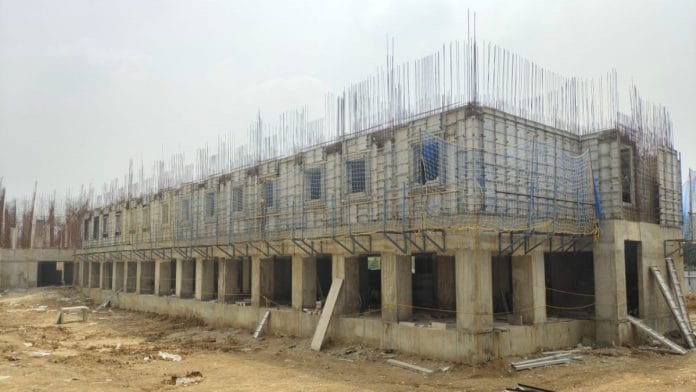New Delhi: The Union government is set to significantly increase the grant for private developers and government agencies to develop rental housing facilities under the revamped Pradhan Mantri Awas Yojana-Urban 2.0 (PMAY-U 2.0), approved by the cabinet on 9 August, despite a muted response to the existing scheme, ThePrint has learnt.
The Ministry of Housing and Urban Affairs is finalising the guidelines for the implementation of the scheme, which are likely to be announced by next month, senior ministry officials said.
For instance, according to senior ministry officials, the revamped scheme will offer Rs 1.5 lakh per unit for the construction of a rental housing complex with one-bedroom flats, measuring 30 square metres. This is an increase from the Rs 60,000 now offered under the Affordable Rental Housing Complex scheme (ARHC), a sub-scheme under the current PMAY-U.
States will also have to pay a portion of the grant given under the affordable rental housing component. For instance, of the Rs 1.5 lakh grant per dwelling unit given to an entity, Rs 90,000 will be paid by the Centre, with the remaining Rs 60,000 to be borne by the states or Union territories, according to senior ministry officials. Earlier, the entire cost was borne by the Centre.
The amount per dormitory will also be increased from Rs 20,000 to Rs 50,000, said another official.
The ARHC scheme was launched in 2020 during the COVID-19 pandemic, which had led to a large-scale exodus of migrant workers from cities. It was aimed at providing rental housing to the urban poor. However, since the scheme was launched, very few rental housing facilities have been developed across the country due to a lack of interest from private developers.
‘Need was felt to amend the existing ARHC policy’
The sub-scheme will now be one of the four main components of the revamped housing initiative. Like the current scheme, it will be implemented under two models: converting existing housing stock constructed by government agencies into rental complexes (model 1) and giving grants to private companies or government agencies to build, operate, and maintain rental complexes (model 2). Both the existing scheme and the new one allow for the construction of one- or two-bedroom houses and dormitories.
The steep increase in the incentive, officials said, could help improve the participation from private companies, under model 2, to develop rental housing for working women, migrant workers and students, among others. Officials said that the policy change is also expected to lead to an increase in the number of hostel-like facilities for the people in these categories.
Under the current scheme, private companies, under model 2, have mostly developed rental housing for their employees. Over the past four years, over 82,000 units have been sanctioned for construction and operation by various private companies, and of this, more than 20,000 units are ready, said an official.
“After a detailed analysis of the current scheme, it was felt that the grant was insufficient to cover the construction and operation cost. A need was felt to amend the existing ARHC policy to make it more lucrative for private parties, as rental housing is the need of the hour. The increase in grants in the new scheme will play a major role in ensuring increased participation from private parties,” said a senior ministry official.
Not a lucrative proposition for private players
Under the existing ARHC scheme, the Centre had proposed that 83,534 flats built by central government-funded schemes would be converted to accommodation for the urban poor and migrant workers. However, according to the PMAY-U dashboard, only 5,648 units have been successfully transformed into rental housing in the past four years.
While real estate experts welcome the Centre’s push for rental housing, they say it is not financially viable for private companies to construct and operate rental housing. They say this could work only in the case of hostel-like facilities.
Samir Jasuja, founder and chief executive officer of PropEquity, said, “Rental housing will not work in India due to low rental returns and high borrowing rates. It can mainly work in providing hostel facilities to students or migrant workers, which is a small part of rental housing.”
The government, experts said, will have to play a proactive role in the development of rental housing in the country by constructing housing stock and then bringing in private players for operation and maintenance.
When asked whether private entities or developers would opt for the rental housing, Jasuja said, “It is commercially unviable. Why would developers go for rental housing where the return is around 2.5 percent when they can earn close to 40 percent return by selling flats? The government needs to provide land and construct housing for rental purposes. It can rope in private players for operation and maintenance.”
Despite municipal authorities in various states trying to bring in private concessionaires to maintain the government-constructed housing complexes and operate them on a rental basis, there was poor response from the private players. Only a few projects in Surat, Chandigarh and other cities were able to convert the existing housing stock into rental housing.
(Edited by Sanya Mathur)






